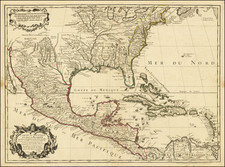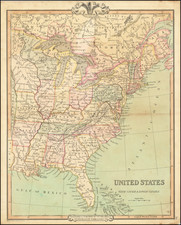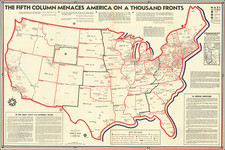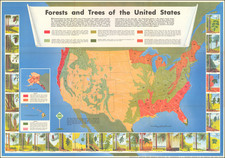Thomas Chrowder Chamberlin Maps The Second Glacial Epoch
Fascinating map of the United States, offering an historical cartographic representation of the glacial deposits in North America from the Second Glacial Epoch, based upon the work of American Geologist Thomas Chrowder Chamberlin in 1882.
This map delineates the distribution and direction of moraines and glacial movements across the northern United States and parts of Canada. The distinct use of colors and directional arrows efficiently illustrates the extent and flow of glacial deposits, emphasizing significant geological features over a vast landscape. This visual depiction of geological data is not only a testament to the cartographic and scientific knowledge of the late 19th century but also a valuable resource for understanding past climatic conditions and geological processes.
The map focuses on the "Endmoräne der Zweiten Glacial Epoche Nord Amerikas" (Terminal moraine of the Second Glacial Epoch of North America), showing symbols for moraine distribution and directions of ice movement, crucial for interpreting the geological data presented.
Thomas Chrowder Chamberlin
Thomas Chrowder Chamberlin (September 25, 1843 – November 15, 1928) was an influential American geologist and educator renowned for his foundational role in the Journal of Geology, which he established in 1893 and edited for many years.
Born in Mattoon, Illinois, Chamberlin moved with his family to near Beloit, Wisconsin, at the age of three. His father was a Methodist circuit minister and farmer.
After graduating from Beloit College in 1866, Chamberlin taught and later became the principal at a nearby high school. His pursuit of advanced scientific training led him to the University of Michigan in 1868–1869, where he studied geology among other subjects. This was followed by his appointment as a professor of natural science at Whitewater Normal School in Wisconsin, where he served from 1869 to 1873. He returned to Beloit as a professor of geology, zoology, and botany in 1873 and simultaneously participated in a detailed geological survey of Wisconsin. His work in glacial geology during this period was pioneering and introduced terms and concepts still in use today.
Chamberlin's growing reputation culminated in his role as chief geologist of the Wisconsin Geological Survey in 1876. His leadership in this role and subsequent publications significantly advanced his career, leading to his appointment as head of the glacial division of the U.S. Geological Survey in 1881. He later served as president of the University of Wisconsin from 1887 to 1892.
In 1892, Chamberlin was invited to organize the geology department at the newly founded University of Chicago, where he taught until 1918 and served as president of the Chicago Academy of Sciences from 1898 to 1914. His contributions to geology include pioneering studies on glaciation and early speculation on the effects of atmospheric carbon dioxide on climate. His 1890 and 1897 papers on the scientific method advocated for the use of multiple working hypotheses, a principle that influenced the development of modern scientific inquiry.
Chamberlin also co-developed the Chamberlin-Moulton planetesimal hypothesis in 1905 with Forest Ray Moulton, proposing a novel theory of the formation of the Solar System. Though later superseded, parts of this theory remain influential. His works and teachings left an indelible mark on geological science and education.
Chamberlin's accolades included election to the American Academy of Arts and Sciences and the U.S. National Academy of Sciences. He was also the recipient of the inaugural Penrose Gold Medal and Penrose Medal, recognizing his extensive contributions to geology.
August Heinrich Petermann (1822-1878) is a renowned German cartographer of the nineteenth century. Petermann studied cartography at the Geographical Art-School in Potsdam before traveling to Edinburgh to work with Dr. A. Keith Johnston on an English edition of Berghaus’ Physical Atlas. Two years later he moved to London, where he made maps and advised exploratory expeditions as they set off to explore the interior of Africa and the Arctic.
In 1854, Petermann returned to Germany to be Director of the Geographical Institute of Justus Perthes in Gotha. There, he was the editor of the Geographische Mittheilungen and Stieler’s Handatlas. The Royal Geographical Society of London awarded him their Gold Medal in 1860. He continued his interest in exploration in Germany, fundraising for the German Exploring Expeditions of 1868 and 1869-70, which sought an open Arctic sea. Tragically, he committed suicide in 1878.













![[ Massive Misplace Idaho Territory ] The United States of North America.](https://storage.googleapis.com/raremaps/img/small/99361.jpg)
